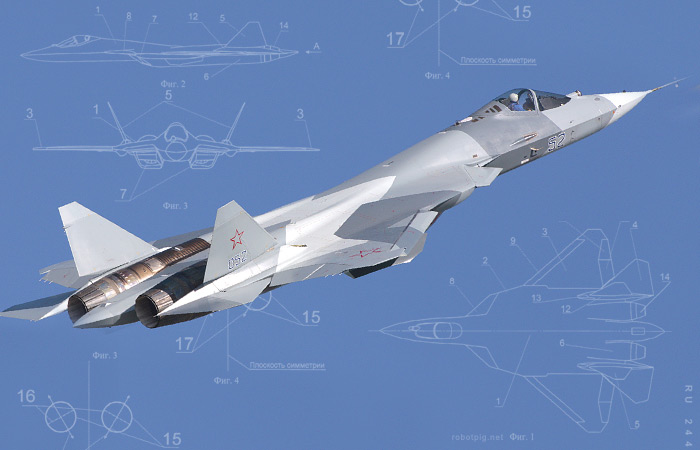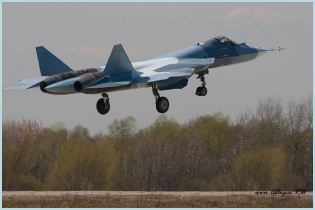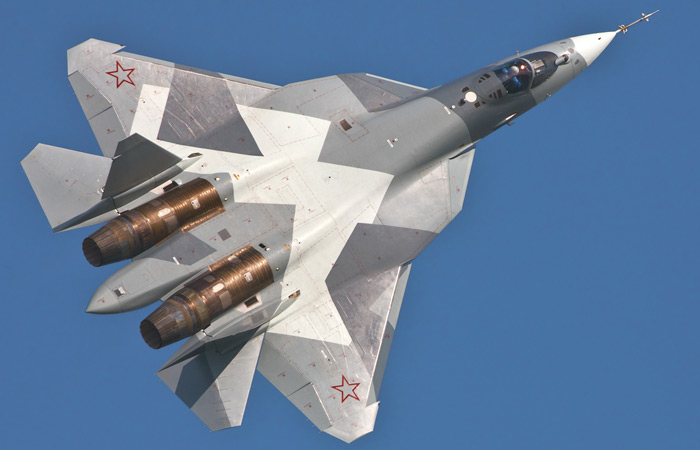The new Sukhoi T-50 / PAK FA Russian fighter is by now quite well known but any official document is certainly welcome. That is the case of the Sukhoi patent that form the basis of this post. Even if it may not bring groundbreaking details, it presents some interesting aspects that may be quite interesting even if they are just raising speculation to fact. This patent document published just yesterday (although submitted by Sukhoi 2 years ago) by the Russian patent office. It presents the general arrangement of the new PAK-FA aircraft, it describes its aerodynamic configuration and function and also some aspects of its design concerning low radar observability.

The T-50 is a substantial evolution of the Su-27 (T-10) family. It has a main trapezoid wing, all moving horizontal and vertical tails and a new kind of canard-like airfoils in front of the main wing (part 8 in the images). There are also slats, flapperons and ailerons. It is worth noting that only theT-50 along with F-22 are the only operational (or to be operational) fighters that are designed from the start with thrust vectoring. All others (ex Su-30) are adapted with movable nozzles at a later stage of their development.
The fuselage is described as having ‘dogtooth extensions’ which are similar in shape and role with the leading root extensions (LERX) of many modern jet fighters and popular with Sukhoi. The fuselage houses the engine and their inlets at its edges and in between it is flattened, providing lift and also space for internal payload. The overall shape with the flat central fuselage, smoothly blended wings and integration of thrust vectoring with all movable surfaces consist what Sukhoi characterizes as integral aerodynamic design.
The wings are smoothly jointed with the flat shaped fuselage via a wide chord created by the negative sweep angle of the trailing edge of the wing. This allows for large values of absolute height especially at the root but small values of relative thickness combining good structural integrity with lower drag forces in the trans and supersonic flight.

One of the most innovative features of T-50 is the movable airfoils above and in front of the inlets. They are more similar to the slats of the main wing rather than Su-30’s canards. These surfaces can rotate downwards around their rear edge. Similar to wing slats, they are rotated to assist control in high angles of attack (close to 90deg.) by reducing the exposed area to the direction of flight and also preserving lift by turning the influx over the fuselage (in a similar manner where slats have the same effect to the wing). These rotary parts shade the main engine inlets but there are auxiliary inlets at the sidewalls of the inlet tunnels where air can flow in avoiding restrictionsThe main wing is equipped with leading edge slats and also with flapperons and ailerons. The flapperons are used in-phase as flaps in take off and landing and moving differentially as ailerons in transonic and supersonic speed. The wing outer ailerons are used only at very low speeds and at take-off/landing to control roll.
Engine placement is a crucial part of T-50’s architecture. The two engines are placed wide apart leaving space for payload between them. The air intakes are located similarly on each side of the fuselage and they are beveled in two planes in order to keep the flow attached even at high angles of attack. The air intakes are further apart in respect to the vertical and horizontal planes than the engines thus the ducts are curved. This curvature hides the compressor and reduces the radar signature of the engine in the forward hemisphere, a common practice in many recent (or not so recent) designs.
IMAGES


No comments:
Post a Comment